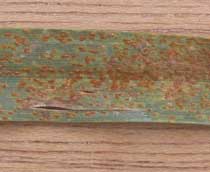
Friends and Foes - Diseases
There are many different sorts of organism that plant pathologists group together under the general heading of 'plant diseases. Fungi cause problems like powdery mildew, an organism known as an oomycete causes potato blight whilst various viruses cause damage to a large range of crops.
To the gardener, the scientific classification of a disease is of little importance - what he or she needs to know is how to deal with it! This quiz will help you identify the diseases that you are most likely to come across and also give you a few tips for dealing with the various associated problems.
Don't forget to click on any of the photos to expand them. Be aware that this is not the prettiest set of images on the Education Quizzes website!
- This damaging disease of roses was prevented in the days of highly-polluted air by the presence of sulfur.
- Oddly, less roses are grown nowadays because of more Black Spot as a result of cleaner air!
- Infected leaves develop black or purple spots and patches followed by the leaves dropping prematurely in late summer.
- Meticulously clear away the leaves around the rose bed each autumn to prevent carry-over of the disease from one year to the next.
- The disease is easily recognized on infected roots because they swell abnormally.
- In the garden the most frequent early sign of clubroot is that plants wilt in warm weather.
- Affected plants are not always killed but the crop potential will be severely restricted.
- The disease is less prevalent in highly alkaline soils.
- Resistant (but not immune!) varieties are gradually being introduced.
- The organism referred to as potato blight is scientifically known as Phytophthora infestans.
- It can also affect tomatoes with equally disastrous consequences.
- Its spread is dependent upon warm, humid conditions.
- Copper based fungicides offer some protection.
- Long-term a solution is likely to be found with the aid of genetic engineering to provide resistant varieties.
- This insidious disease is the most destructive fungal disease that gardeners have to deal with.
- It lives on and kills plant roots.
- Most of the activity takes place underground but now and again brown fungi, such as those in the picture, appear at the base of infected plants.
- No chemical controls are available.
- The only long-term solution is to excavate and destroy all infected roots, bark and other plant material.
- Typically powdery mildew first appears as isolated powdery spots on the leaf surface but these spread rapidly and sometimes completely cover the leaf.
- It is distinguishable from downy mildew by virtue of the fact that powdery mildew always has a 'powdery' appearance.
- Frequent spraying with plain water helps keep the disease at bay and infected leaves should be taken off as soon as possible and destroyed.
- There are over 7,000 different 'varieties' in the group of fungi that create this type of speckling on plant leaves.
- Plants are seldom killed but yields are greatly depleted.
- Plants affected range from wheat to forest trees.
- In the garden it is most troublesome on chrysanthemums, fuchsias, pelargoniums and roses.
- Destroy affected leaves and employ strict regimes of hygiene.
- If you have ever grown bedding plants from seed then you will almost certainly have seen damping off!
- Patches of seedlings collapse and die extremely quickly.
- Ensuring that the compost is not too wet and is occassionally allowed to dry out a little is the best means of preventing the disease.
- Always use clean (washed and sterilized) seed trays and pots.
- When conditions are ideal for the spread of fireblight it can spread rapidly and wipe out an entire orchard in a single growing season.
- Affected stems wither and go black just as they would if scorched by fire, hence the name fireblight.
- The plants most badly affected are apples and pears but some ornamental plants such as Cotoneaster and Pyracantha are also vulnerable to attack.
- Prune affected branches and destroy immediately.
- This problem spreads only slowly through an area of trees.
- Apple canker (caused by a fungus) is the most frequently seen form in the UK.
- Usually the disease can be kept in check by regularly pruning out any affected areas. In severe cases a copper-based fungicide may prove useful.
- A serious disease that has to be dealt with by fruit growers.
- It can be devastating in a vineyard.
- Equally it can ruin a crop of tomatoes or strawberries.
- Its rapid spread and severity is made worse by damp, humid conditions when the air 'stagnates'.
- Much can be done to prevent the disease on strawberries by ensuring that there is a good layer of straw beneath the ripening berries.
- In glasshouses, always ensure adequate ventilation.
Ready for more?
not all...
quizzers. Try to win a coveted spot on our Hall of Fame Page.

















